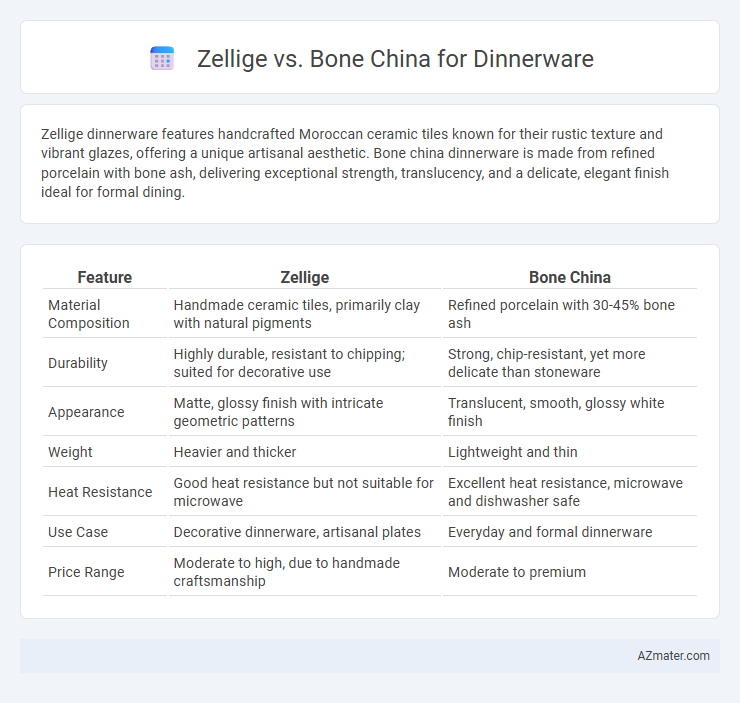Zellige dinnerware features handcrafted Moroccan ceramic tiles known for their rustic texture and vibrant glazes, offering a unique artisanal aesthetic. Bone china dinnerware is made from refined porcelain with bone ash, delivering exceptional strength, translucency, and a delicate, elegant finish ideal for formal dining.
Table of Comparison
| Feature | Zellige | Bone China |
|---|---|---|
| Material Composition | Handmade ceramic tiles, primarily clay with natural pigments | Refined porcelain with 30-45% bone ash |
| Durability | Highly durable, resistant to chipping; suited for decorative use | Strong, chip-resistant, yet more delicate than stoneware |
| Appearance | Matte, glossy finish with intricate geometric patterns | Translucent, smooth, glossy white finish |
| Weight | Heavier and thicker | Lightweight and thin |
| Heat Resistance | Good heat resistance but not suitable for microwave | Excellent heat resistance, microwave and dishwasher safe |
| Use Case | Decorative dinnerware, artisanal plates | Everyday and formal dinnerware |
| Price Range | Moderate to high, due to handmade craftsmanship | Moderate to premium |
Introduction to Zellige and Bone China Dinnerware
Zellige dinnerware features handcrafted Moroccan tiles known for vibrant geometric patterns and a rustic, artisanal aesthetic that enhances table settings with cultural heritage and unique texture. Bone china dinnerware, composed of bone ash, kaolin, and feldspar, is prized for its lightweight durability, translucent whiteness, and refined elegance, making it a popular choice for formal dining occasions. Both materials offer distinct advantages: Zellige emphasizes artistic craftsmanship and bold design, while bone china provides sophistication and practicality.
Historical Background of Zellige and Bone China
Zellige, originating from Moroccan craftsmanship dating back to the 10th century, is renowned for its intricate, hand-cut tile patterns used historically in architectural decor. Bone china, developed in 18th century England by Josiah Spode, incorporates bone ash for enhanced strength and translucency, transforming traditional porcelain into a durable and elegant dinnerware material. Both materials reflect rich cultural heritages, with Zellige emphasizing artisanal geometric design and Bone china representing innovation in ceramics technology.
Material Composition and Craftsmanship
Zellige dinnerware features handcrafted ceramic tiles made from natural clay, known for their intricate mosaic patterns and textured surfaces, highlighting traditional artisan techniques from Morocco. Bone china is composed of refined porcelain mixed with bone ash, providing a lightweight yet durable structure with a translucent quality, achieved through precise kiln-firing processes. The craftsmanship of Zellige emphasizes geometric design and manual glazing, while bone china prioritizes smooth finish and strength through industrial refinement.
Aesthetic Appeal: Color, Pattern, and Texture
Zellige dinnerware features vibrant, hand-glazed colors with intricate geometric patterns and a textured, tactile surface that adds a unique artisanal charm to table settings. Bone china offers a smooth, translucent finish with delicate, often floral or minimalist patterns in soft, muted tones, exuding elegance and refinement. The choice between Zellige's bold, rustic aesthetic and bone china's classic, polished look depends on whether you prefer a striking artistic statement or timeless sophistication.
Durability and Longevity Comparison
Zellige dinnerware, crafted from glazed terracotta, offers robust durability with resistance to chipping and heat, making it ideal for everyday use and long-term wear under regular handling. Bone china, composed of refined clay mixed with bone ash, boasts exceptional strength and chip resistance despite its delicate appearance, providing longevity when carefully handled but may require more cautious use to avoid breakage. Durability in Zellige leans toward heavy-duty resilience, while bone china balances elegance with surprisingly high resistance, ensuring both materials sustain quality over time depending on usage conditions.
Practicality: Usability and Maintenance
Zellige dinnerware offers high durability and resistance to chipping, making it practical for daily use, but it requires careful handwashing to preserve its intricate glaze. Bone china is renowned for its lightweight strength and chip resistance, and it is dishwasher safe, enhancing usability and low-maintenance appeal. Both materials combine elegance with practicality, yet bone china excels in ease of maintenance and suitability for frequent use.
Cost and Accessibility
Zellige dinnerware offers a unique handcrafted aesthetic often produced in limited quantities, leading to higher costs and less widespread availability compared to bone china. Bone china is widely mass-produced, making it more affordable and readily accessible in various designs and retailers globally. Consumers seeking durable, elegant dinnerware with broad market presence typically find bone china more cost-effective and easier to purchase than Zellige pieces.
Environmental Impact and Sustainability
Zellige tiles, crafted from natural clay and glazed with mineral-based pigments, offer an eco-friendly option due to their low-energy production process and biodegradability, making them sustainable for dinnerware use. Bone china, made from refined clay mixed with bone ash, involves higher energy consumption and raises ethical concerns due to animal-derived materials, impacting its environmental footprint negatively. Choosing Zellige supports sustainability through renewable raw materials and minimal waste, while bone china's production contributes to increased carbon emissions and resource depletion.
Ideal Occasions for Each Dinnerware Type
Zellige dinnerware, with its handcrafted ceramic patterns and vibrant colors, is ideal for casual gatherings, themed parties, and artistic dinner settings that emphasize cultural aesthetics and individuality. Bone china, known for its delicate translucency and elegant finish, suits formal occasions such as weddings, upscale dinner parties, and holiday celebrations where sophistication and refinement are paramount. Choosing between Zellige and bone china depends on the desired ambiance, with Zellige favoring relaxed, creative environments and bone china enhancing traditional, luxurious dining experiences.
Choosing the Right Dinnerware: Zellige or Bone China?
Choosing between Zellige and Bone China for dinnerware involves weighing durability against elegance, as Zellige offers a handcrafted, rustic appeal ideal for casual or artistic table settings, while Bone China provides a refined, translucent finish perfect for formal dining. Zellige dinnerware, made from glazed terracotta, is highly durable and resistant to chipping, making it suitable for everyday use, whereas Bone China's delicate composition of bone ash, feldspar, and kaolin ensures lightweight strength but requires careful handling. Consider the intended dining atmosphere and maintenance preferences to select dinnerware that complements both lifestyle and aesthetic needs.

Infographic: Zellige vs Bone china for Dinnerware
 azmater.com
azmater.com